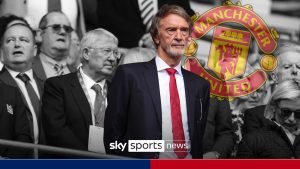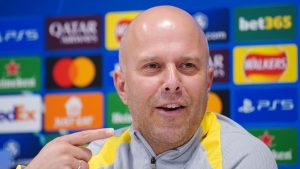Charity founded by disgraced cyclist announces relaunch plan


AUSTIN, Texas (AP) — The cancer charity whose yellow wristbands became a global brand under founder Lance Armstrong is seeking to reinvent itself, years after donations and revenues crashed along with the disgraced cyclist’s career.
Armstrong was nowhere to be seen earlier this month during Livestrong’s “relaunch” ceremony in Austin. The charity announced plans to end its one-on-one cancer support services, where a patient could call for help dealing with insurance, counseling and medical trials. Instead, it will pivot to spending $5-6 million annually to support entrepreneurs developing products to improve treatment and patient care.
Livestrong will maintain its partnership with the Livestrong Cancer Institutes at the University of Texas Dell Medical School, which focuses on cancer research, patient care and treatment.
“We’re more than a wristband,” Livestrong President and CEO Greg Lee told a crowd of about 200 gathered for the event. A few minutes earlier, Gloria Gaynor’s 1970s hit single “I Will Survive” pumped out of the speakers.
Livestrong’s trademark yellow wristbands were once worn by celebrities and politicians the world over. Donations and commercial ties to athletic apparel company Nike brought in tens of millions annually.
But those days are gone. The wristbands are rarely seen anymore, and Nike ended its Livestrong clothing line years ago.
The legacy and reputation of Armstrong, a cancer survivor who won the Tour de France seven times, crumbled abruptly following revelations he used performance-enhancing drugs. Livestrong has chugged along as a much smaller, leaner organization.
The relaunch came with an artistic redesign. Gone is the yellow-and-black “Livestrong” logo that mimicked the wristband, which is still available for purchase online. The logo has been replaced by a blue background with three rings — orange, blue and yellow.
“We’re nimble,” Lee said. “We’re not like an ocean liner. We’re more like a jet ski that can turn on a dime.”
Lee insists the move is about better serving cancer patients, not just reversing declining financial trends.
Livestrong was a pioneer in providing one-on-one help to guide people through difficult and sometimes traumatic cancer diagnosis and treatment. The model has been successfully copied by many. The company therefore needs to find new, unique ways to help patients, Lee said.
A money drain also needs attention.
Armstrong founded Lance Armstrong Foundation in 1997 after he was diagnosed with testicular cancer that had spread to his lungs and brain. His remarkable recovery and success on the world’s biggest stage for cyclists fueled a boom that transformed the once small charity into a global force.
At its peak, Livestrong took in $41 million in donations in 2009 when Armstrong came out of retirement to finish third in the Tour de France. The downturn came when Armstrong’s career and reputation were undone first by a 2012 investigation in performance-enhancing drug use and his 2013 confession in a televised interview with Oprah Winfrey.
The charity desperately tried to distance itself from the scandal. Armstrong was pushed out of his role as chairman of the board of directors — he remains listed as a board emeritus member but is otherwise not involved — and the foundation’s name was formally changed to Livestrong.
According to 2018 financial records, the most recent available, donations and revenue had dipped under $2.5 million. Assets listed at $100 million a decade ago have been whittled to $46 million. That includes a $37 million endowment, which has about $15 million tied to specific spending restrictions.
The 2018 report doesn’t reflect the $17 million sale in 2019 of Livestrong’s former headquarters in downtown Austin.
With that money in the bank, analysts at charity watchdog groups Charity Navigator and Charity Watch still give Livestrong good marks for being financially healthy overall and transparent in how it spends. And donations at least have leveled off from their initial plummet.
But Livestrong still spent three times what it takes in on it national partnership with the YMCA, the local one with the University of Texas, and operating expenses. Lee’s salary is about $350,000 a year.
“They are going to have to increase revenue or decrease spending. It will be a question of how they maintain that revenue,” said, Kevin Doyle analyst with Charity Navigator.
Lee said Livestrong will shift from it’s main fundraising model from one that depends on contributions at large to one that more aggressively seeks corporate and venture-capital partnerships to support its grants and gifts.
Grants could support a wide range of tools for helping cancer patients, such as transportation services or smart phone applications that help patients organize treatment records or connect with multiple physicians, Lee said
Livestrong still has a formidable brand that will likely attract interest from grant applicants and investors, said Daniel Borochoff, founder of Charity Watch.
“They are still a high-profile group,” Borochoff said. “People will be motivated to have the Livestrong name backing them.”
A decade ago, Armstrong’s towering presence alone could draw money as he dominated the world’s most famous bike race or flew around the world to meet with celebrities and political leaders at global cancer forums. Back in 2007, it was Armstrong’s late-hour lobbying that pushed Texas lawmakers to pass a $3 billion cancer research fund.
But his divorce from Livestrong was bitter. Armstrong’s name and image were completely scrubbed from the re-launch celebration.
There were no photographs of Armstrong used in a video compilation of cancer patients and celebratory moments. His presence was missing from a display charting the foundation’s first two decades, which included a large bowl filled with yellow Livestrong bracelets.
One speaker mentioned the foundation had been through good times and bad. Only the event host’s passing reference to a “famous founder” seemed to acknowledge his impact in starting it all.
A Livestrong spokeswoman said the charity offered to brief Armstrong ahead of the unveiling party, but he declined. Armstrong declined comment when contacted by The Associated Press.
“We have done everything we can to talk to tell people that (Livestrong) is not about one person,” Lee said. “We have a changing focus, a new mission and a new visual identity.”






